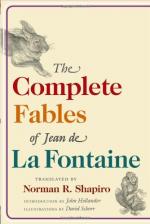|
This section contains 6,376 words (approx. 22 pages at 300 words per page) |

|
SOURCE: "Reason and Rhetoric in the Fables of La Fontaine," in Australian Journal of French Studies, Vol. XVI, Part 3, May-August 1979, pp. 347-60.
In the following essay, Moravcevich asserts that La Fontaine uses the seventeenth-century tools of reason and rhetoric in a complex but classically. pleasing manner via his animal characters and ultimately in order to instruct his readers in "wisdom rather than morality."
Both reason and rhetoric enjoyed considerable prestige in France in the first half of the seventeenth century and coexisted harmoniously in the works of such writers as the epistolographer Guez de Balzac, the dramatist Pierre Comeille, and the philosopher René Descartes.1 In the realm of literature not only were writers required to be masters of the art of rhetoric, but even their characters, however intense their emotions, were expected to follow the lessons of rhetoric in developing and structuring their thoughts and in expressing them...
|
This section contains 6,376 words (approx. 22 pages at 300 words per page) |

|


